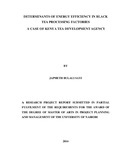| dc.description.abstract | The purpose of this study was to examine determinants of energy efficiency in black tea processing factories. It was guided by four main objectives which sought to determine the influence of capacity utilization, energy efficient technology machines, technical staff awareness and energy mix on energy efficiency. The target population for the study comprised sixty five KTDA managed black tea processing factories. The researcher employed descriptive and empirical research designs for answering the four research questions. The sample size for the study of technical staff awareness was obtained by using the Yamane (1967) simplified formula for calculating sample size. It yielded two hundred and twelve technical staff out of a target population of four hundred and twenty likely respondents. A representative sample for questionnaire administration from the seven regions was achieved through cluster sampling and balloting. The study of the remaining variables involved document review from the sixty five target factories. The researcher adopted a census approach to minimize sampling errors. Research questionnaires for technical staff awareness were developed, evaluated, pilot tested and revised with the assistance of KTDA technical staff before being mailed to regional information technology coordinators who were engaged to administer them in the field. A reliability test was carried out and a reliability coefficient of 0.85 obtained using the split half technique. Questionnaire respondents were guaranteed confidentiality through an introduction letter. A high response rate of 96% was achieved. Collected data was analyzed using the internet based free statistics software for social scientists. Results from the study show that capacity utilization has a weak to moderate positive influence on energy efficiency, energy efficient technology machines showed mixed results on their influence on energy efficiency. Although technical staff energy efficiency awareness was high, above 95% in all the study samples, it showed no influence on energy utilization efficiency. According to research findings, energy mix had the greatest influence on energy efficiency. Among the energy mix semi- variables, fuel wood accounted for the highest proportion at 91.1% and was negatively correlated to energy efficiency. Electrical energy accounted for 8.6% and is positively correlated to energy efficiency. Boiler furnace oil had the least percentage by proportion at 0.3% with mixed results in its correlation relationship with energy efficiency among the different regions. These findings may assist the local tea industry to prioritize energy efficiency improvement measures starting with fuel wood, electrical energy and lastly furnace oil. Energy policy makers, the energy regulatory commission and Green House Gas emission advocates may use the findings to plan and focus their activities towards high impact results areas. The study recommends that more focus should be directed towards fuel wood management and the establishment of an elaborate system to assess energy efficiency performance of newer machinery technologies. The researcher has recommends further research to be carried out in order to establish why fuel wood has a negative influence on energy efficiency. This is important since this form of energy accounts for over 90% of current energy needs. | en_US |

